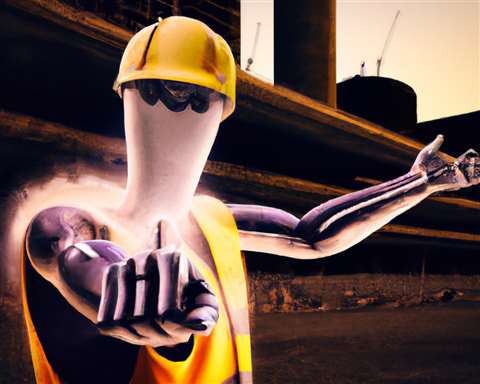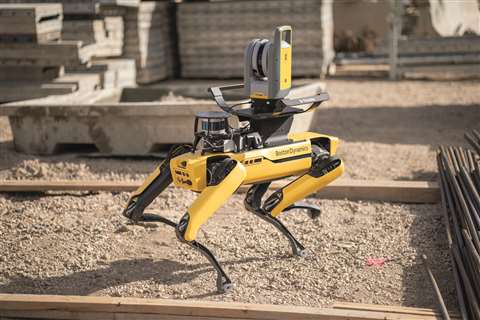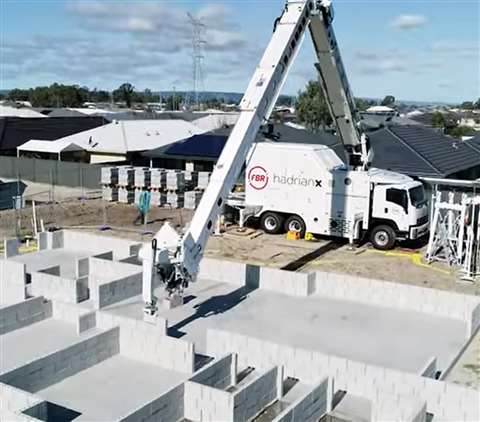Is artificial intelligence out to steal your construction job?
24 April 2023
 This image was created with the assistance of DALL.E.2
This image was created with the assistance of DALL.E.2
In Douglas Adam’s fictional novel of the same name, the Hitchhiker’s Guide to the Galaxy was a very advanced but famously unreliable electronic guidebook to space travel.
The Guide bore a simple but reassuring message on its front cover: ‘Don’t Panic’.
It’s advice worth remembering as the wider world grapples with the advent of artificial intelligence (AI).
AI has rapidly entered the public consciousness thanks to the arrival of services like ChatGPT, Google’s Bard, and image generation tools like Midjourney and Dall.E.2.
Microsoft co-founder Bill Gates recently declared AI the most important technological advance in decades and professionals in all sorts of industries across the globe have started to ask themselves what it means for the world of work and whether it could ultimately make some jobs redundant.
So what does it mean for construction professionals in particular? That’s what International Construction has set out to discover, with the help of experts in AI as it applies to the construction industry.
Are the worst fears justified that it might replace humans completely? Or could it serve as a means to enhance productivity and take the mundanity out of work to allow humans to focus on what they are really good at?
It’s not as new as you think
First of all, AI isn’t as new a phenomenon as it appears to be, says Stefana Parascho, tenure track assistant professor, in the laboratory for creative computation at the École Polytechnique Fédérale de Lausanne (EPFL) in Switzerland.
Parascho now works on developing robotic construction methods and the practical implication of those methods. But she originally trained as an architect.
“AI has been around for quite a while now. It’s true that it has been evolving quicker and quicker: We can see that with Chat GPT, Midjourney and things like that, that are so accessible now to everyone. But I do think it’s worth being aware that it’s not a completely new thing. It has been around for a long time,” she says.
“There’s always been this fear of AI and robots replacing human workers. And I think it’s been reiterated many times that even though it’s evolving so fast, it’s nowhere near a place where it can fully replace humans and human work.”
Automating mundane tasks and streamlining workflows
Where AI can help almost immediately is by taking over repetitive and mundane office tasks. And that applies just as much to construction work as any other field.
 Boston Dynamic’s Spot robot mounted with Trimble data collection sensors (Image: Trimble)
Boston Dynamic’s Spot robot mounted with Trimble data collection sensors (Image: Trimble)
“I’d imagine zero to almost zero architects, engineers and construction managers want to spend their time reviewing emails, answering basic questions, preparing PowerPoints or formatting Excel reports,” says Danny McGough, assistant professor in the school of energy, construction and environment at Coventry University in the UK.
McGough specialises in Building Information Modelling (BIM), architectural technology and construction management.
“Being focused in these areas I’m a natural advocate of digital fluency and technology adoption.
“However, the downside of this is that we spend a lot of time learning new software, processes, reviewing data and putting this information into accessible formats such as design plans, 3D models, visualisations, presentations, and spreadsheets,” he says.
“AI could reduce the load of these processes, allowing us more time to innovate and concentrate on the unique human centric value we can add.”
AI’s potential implications for…
...construction management
AI is likely to prove very effective for planning construction processes more efficiently.
But Parascho doesn’t think that this threatens the role of a human project manager or construction manager.
“Planning construction processes is a very complex task and AI can make it more efficient. But I do think there is a danger that if everything is planned out computationally, it relies on assumptions on what a human’s role is in the process and what they are capable of,” she says.
She cautions against regarding humans as machines in a big system and that is where human project managers can continue to play a valuable role because they understand their colleagues’ day-to-day capabilities and limitations better than a machine and can react accordingly.
“Humans are not machines. They make mistakes and some might work more quickly or slowly than others. That’s something that could get lost if we try to pre-plan every move,” she says.
…architecture and design
AI hasn’t yet had as significant an impact on architecture as was perhaps predicted, although that could yet change.
“There were really big expectations when image generators like Midjourney came out that it would enable architects to generate completely unexpected new things and could take over the creative part of the process of designing,” says Parascho.
But so far that hasn’t proven to be the case. “We realised that anything the AI generates relies on a very specific prompt. So it turns the exercise into how to describe really well what you are already thinking about. That’s a completely different way of working. But it’s not necessarily going to generate something new and unexpected. These tools rely on existing images and data. So there is a limit to how creative it could actually be.”
That’s a point McGough makes too: The most recent data that ChatGPT works from, for example, dates from 2021 and earlier (although Google’s Bard promises to be fully up-to-date).
But where he sees its strength as far as design is concerned is sorting through all of that data.
“AI won’t (for the foreseeable future) state whether a buildings aesthetic is pleasantly pleasing, it won’t be able to evaluate the emotions or feeling that a project team or client has when reviewing the designs. But tools like Chat-GPT can analyse this vast library of data exponentially faster that humans can which is where its strength is, in that speed of access and response,” he says.
“Does a human need to spend weeks working through multiple iterations of a concept design or can AI be given a brief, given a project or design outline and then work through this laborious task for us?”
…autonomous machines and on-site robotics
 Australian company FBR has developed the Hadrian X bricklaying robot to lay bricks autonomously (Image: FBR)
Australian company FBR has developed the Hadrian X bricklaying robot to lay bricks autonomously (Image: FBR)
Where Parascho does see AI being able to make a significant impact in construction is by making robotics and autonomous machinery more accessible.
“Right now, every robot has its own programming language and interaction protocols. You need to have someone with quite specific skills to set these robots, programme them and get them to do what we want them to do,” she explains.
“AI can make the use of robots more accessible. There’s a lot of use of AI and computer vision to make autonomous machines more aware of their surroundings, which is necessary for construction because sites are messy and unpredictable.”
In time, the successful application of such technology could reduce the need for machine operators as well as some manual trades like bricklayers but it is still a long way off being ready to take over from humans.
Where it is perhaps closer to being ready is when it comes to certain tasks like site surveys, where machines like Boston Dynamics’ Spot robot mounted with Trimble data collection sensors, or hard-hat-based technology like Open AI are already starting to have an effect.
…engineering
Meanwhile, Parascho sees the potential for AI to help engineers with complex calculations. “I think there is a lot of potential for making these calculations faster and easier to access,” she says.
And McGough sees potential in AI’s ability to carry out extensive quality control checks. For example, it could be used to make sure that engineers have met all the safety standards with the structural design.
…quantity surveying and cost consultancy
Similarly, McGough sees the potential for AI to make sure quantity surveyors have included all the relevant building elements in the costing.
But he doesn’t see it replacing such a role wholesale. “When BIM first came on the scene, there were whispers that it would mark the end of quantity surveyors, however this simply wasn’t the case. BIM didn’t eradicate the role but rather improved productivity by removing menial tasks.
“You would never hand over a final costing generated by software of AI straight to the client and demand payment aligned to that. It would always be reviewed by the relevant expert to ensure the information was accurate.”
…data management
AI could provide a major advantage in the management of the huge volumes of data that construction projects now create and which are essential for managing a built asset throughout the rest of its life, McGough says.
“Vast amounts of this data currently go to waste and stay lost in the limbo of closed-off and redundant project information,” he says. “We can utilise AI to help interpret this data and make it more accessible for expert users to analyse and validate.”
He points to the way in which the construction industry already uses complex software to evaluate energy design data.
“Software helps assist in breaking down this information through accessible tools and interfaces such as Autodesk Insight, Green Building Studio and Integrated Environmental Solutions (IES), which convert the raw data into useful and accessible information.
“As AI evolves and develops, we can use machine learning to take our analysis software to the next level. Instead of spending hours and days preparing models and pushing them through the software we can instead concentrate on key project and design decisions. These can then be discussed with the team of trained experts (whom will have more time to actually talk to each other and collaborate) using the accessible information produced through the software and AI platforms,” he adds.
Conclusion
Parascho declares herself an optimist when it comes to technology in general and that applies to AI too. “It has never been a question of replacing humans,” she says. “I really do see the advantages of it and where we can employ it. It really is a means of enhancing what we can do.”
What AI can’t do – and what it shows no signs yet of being able to do – is to handle a construction project from start to finish.
McGough warns that AI can and will get things wrong. “Discipline experts will be required to validate any outputs it produces,” he says.
“We can’t just leave a tool like Copilot AI to write out an email to a client or our boss unmoderated. For the foreseeable future, we need experts to review the data and information AI produces using the experience and knowledge they have gained over the years to evaluate the best path forward for a project.”
So your construction job is probably safe for now. But it probably will change the way people work in many different roles. And they will need to be prepared for that change.
McGough concludes, “AI won’t suddenly make all roles redundant but will naturally force roles to evolve and adapt, learn where new technology can assist, and adopt the areas of AI and machine learning which add value. If they don’t then dare I say they do risk becoming obsolete.”
What ChatGPT thinks about AI’s effect on construction jobs
International Construction asked ChatGPT: “What jobs will AI replace in the construction industry?” Here’s what it thinks:
The construction industry is complex, and there are several jobs that AI could potentially replace in the future. Here are some examples:
- Surveyors: AI can analyze digital maps and blueprints to accurately survey a construction site. This could potentially replace traditional surveyors who use physical tools to take measurements.
- Project Managers: AI can help manage projects by optimizing scheduling, resource allocation, and workflow. This could reduce the need for human project managers.
- Safety Inspectors: AI can analyze safety data and identify potential safety hazards on construction sites. This could potentially replace some safety inspectors who manually inspect sites.
- Equipment Operators: AI could potentially replace equipment operators, such as crane operators and excavator operators. Autonomous heavy equipment is already being tested in some construction sites.
- Construction Workers: While AI may not completely replace construction workers, it could potentially automate certain tasks, such as bricklaying and welding.
It’s important to note that while AI may replace some jobs in the construction industry, it could also create new jobs and opportunities as the industry evolves.
STAY CONNECTED



Receive the information you need when you need it through our world-leading magazines, newsletters and daily briefings.
CONNECT WITH THE TEAM








